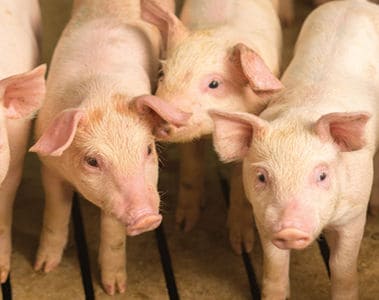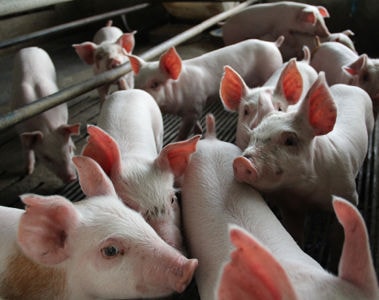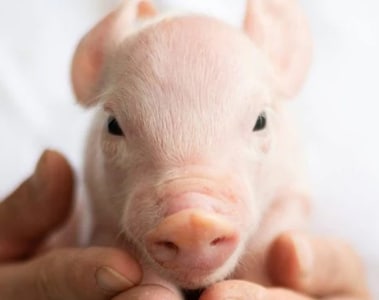In the pursuit of sustainable swine agriculture, the selection of feed and the incorporation of enzyme supplements are of paramount importance. Especially in the United States, where corn and soybean are cornerstones of the typical swine diet, enzymes offer transformative potential. Not only do they enhance the nutritional value of these mainstay feeds, but they also champion environmentally friendly swine feeding practices. Beyond just conventional diets, enzymes also show promise in optimizing alternative feed sources. This article explores the scientific foundations of enzyme benefits, the burgeoning potential of alternative feedstuffs, and the nuances of diet granularity.
The influence of wheat type and xylanase supplementation
Understanding the impact of wheat types and enzyme supplementation on pig nutrition is essential for improving growth and feed efficiency. A study revealed that the choice of wheat significantly influenced feed intake and growth in the initial stages of pig development. However, the only lasting effect was on the growth rate, emphasizing the need for sustained nutrition.
Xylanase supplementation was pivotal in enhancing pig performance and bridging the nutritional gap between wheat varieties (Cadogan et al., 2015). Furthermore, Cadogan et al. (2015) highlight that xylanase boosted energy and dry matter digestibility in the gut, emphasizing the role of enzyme supplementation in nutrient utilization. This underlines the importance of both the type of wheat and the inclusion of xylanase in swine diets.
Enhancing sow nutrition and lactation performance
We already know that lactating sows play a critical role in overall swine production, and their nutrition directly impacts piglet growth. A study demonstrated that supplementing mono-component xylanase to sow diets based on wheat, barley, and soybean meal significantly improved feed intake and nutrient digestibility (Zhou et al., 2018). It effectively reduced weight loss in sows during lactation, enhancing overall performance. This improvement was attributed to increased energy and nutrient digestibility, emphasizing the pivotal role of enzymes in sow nutrition. As piglets rely heavily on their mother's milk, this boost in nutrient utilization has downstream effects on piglet growth and health.
The role of enzymes in swine nutrition
Enzymes, nature's remarkable catalysts, have sparked a revolution in various industrial applications with a significant impact on animal feed production. Among the array of feed enzymes, including phytases, carbohydrases, and proteases, their role in augmenting feed utilization and minimizing environmental footprints stands out. They function to enhance the efficient utilization of nutrients, broaden the range of suitable feed ingredients, and bolster gastrointestinal health in animals. The application of enzymes demands a thoughtful evaluation of substrate specificity and feed composition, offering substantial cost savings and improved animal performance (Glitsoe et al., 2015).
The use of enzyme supplementation in swine diets has garnered substantial attention, particularly in the wake of the European Union's ban on antibiotic growth promoters. Within this domain, two classes of enzymes have proven to be instrumental: phytases, responsible for liberating bound phosphorus, and non-starch polysaccharide (NSP)-degrading enzymes, specialized in breaking down intricate molecules found in cereal grains and oilseed meals. These enzymes play a critical role in elevating the nutritional value of pig diets, facilitating the release of nutrients for efficient absorption (Altemueller et al., 2007).
In addition to these essential enzymes, combinations of multiple enzymes have also demonstrated significant potential in swine nutrition. These combinations, which may include enzymes like xylanases, glucanases, and phytases, work in tandem to break down a broader spectrum of antinutritional factors found in swine feeds. Complementary enzyme blends can effectively tackle diverse dietary challenges, such as bolstering protein digestion and enhancing fiber utilization. By leveraging the synergistic effects of these enzyme combinations, swine nutritionists can optimize feed efficiency and encourage more sustainable and healthier practices in pig farming (Torres-Pitarch et al., 2019).
Reducing environmental impact with enzyme supplementation
Reducing the environmental footprint of swine production is a pressing concern. Enzyme supplementation has shown promise in this regard. A study assessed the environmental burdens of enzyme supplements, focusing on xylanase. This enzyme significantly reduced contributions to global warming, acidification, energy use, and nutrient enrichment. Studies supported that combining xylanase with phytase further enhanced the reduction of various environmental impacts, making enzyme supplementation an eco-friendly choice (Nielsen et al., 2008).
Digestibility of carinata meal for growing pigs
Carinata meal is an increasingly important feed ingredient for pigs, and researchers have explored ways to enhance its nutritive value. The study focused on the standardized ileal digestibility of amino acids and energy values in carinata meal for growing pigs. The addition of phytase and multicarbohydrase enzymes significantly improved digestibility and energy values (Hong et al., 2019). This reinforces the idea that enzymes can unlock the potential of unconventional feed ingredients for swine nutrition.
Particle size and amylase supplementation
Another crucial aspect of swine nutrition is the particle size of diets and amylase supplementation. Finer diets led to lower feed conversion ratios in younger nursery pigs, while coarser diets improved feed intake and weight gain in older pigs. Amylase supplementation consistently enhanced growth performance, nutrient digestibility, and energy utilization across all diets, emphasizing its potential in swine nutrition (Dzierva et al., 2023).
Conclusion
There's a strong connection between the type of dietary ingredients used, enzyme supplementation, and their combined impact on swine nutrition and environmental sustainability. By understanding and harnessing these relationships, swine producers can optimize their operations for greater efficiency, reduced environmental impact, and improved profitability.


